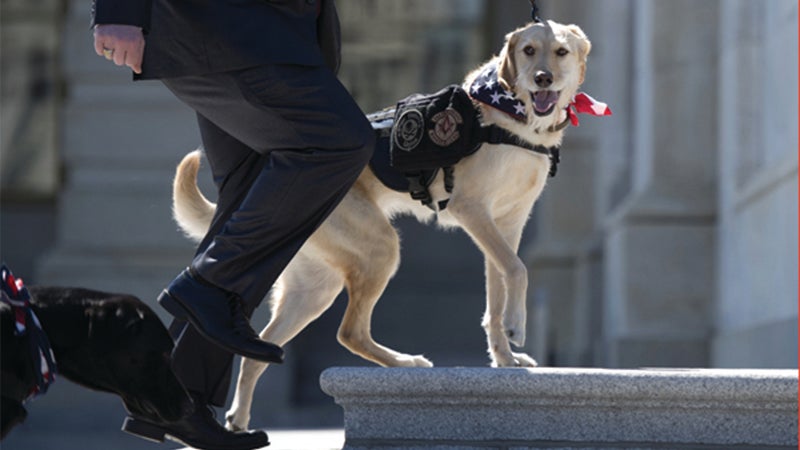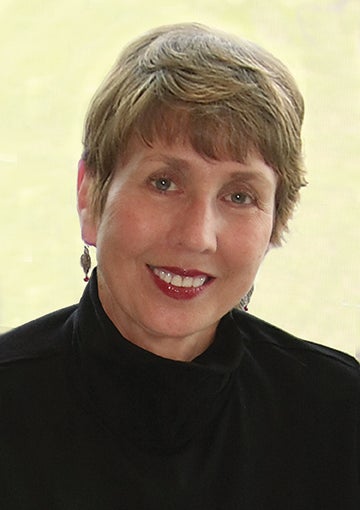More than a Man’s Best Friend: “Molly to the Rescue” shares the story of a veteran’s elite service dog
Published 2:04 pm Monday, October 2, 2017
Recently, author Sally Hursey sat down with Foothills Magazine writer Linda List to discuss Hursey’s recently published book that draws attention to the life of a service dog, particularly one who was trained in a program to aid a veteran with PTSD. Here is their conversation.
Linda: Let’s talk about your book “Molly to the Rescue” that came out in July. How did you come to write this true story of a dog and a veteran?
Sally: I was at my veterinarian’s office in July of 2015 to talk with her about a problem I was having with one of my dogs. A woman with a rambunctious, large dog sat across from me talking to the woman beside her. I listened in on their conversation as the woman with the dog talked about Service Animal Project, a program with the Foothills Humane Society. She said the organization rescues dogs from shelters that may be candidates for training as service dogs for veterans with Post-Traumatic Stress Disability (PTSD). The woman said the dog with her was there to be evaluated by the veterinarian. If the dog passed and was trainable, he might become a member of the K9s for Warriors program. This was the first time I had heard of Service Animal Project, a local rescue organization, and K9s for Warriors located near Jacksonville, Fla. I thought to myself, this is an amazing story. Our local shelter dogs are becoming elite service dogs for veterans with PTSD. When I met Molly, a terrier/golden retriever mix, I knew I wanted to write about her journey from a lonely shelter dog to becoming an elite service dog for a veteran.
Linda: I think adults will enjoy this story and find it interesting. Why did you decide to write this book as a children’s book?
Sally: It is estimated that approximately four million children have a parent with PTSD. Every 65 minutes a veteran commits suicide in this country; that translates to 22 a day. I wanted to write a book suitable for children as well as adults, so I chose to write this book as a chapter book appropriate for children ages 8 and up, as well as adults. I want to educate the public about this dire situation and show there is hope for our suffering veterans. The thought of using rescue dogs to save our veterans touched my heart. I knew this was a story I was meant to write.
Linda: Why did you choose to write the story from Molly’s point of view? It was effective to think about the situation, as a dog might perceive it. At times I found it heart-wrenching.
Sally: I wrote the story from Molly’s point of view (first person) first. Then I tried it in a third person point of view and it seemed impersonal. There was no comparison. The story came alive with Molly telling it!
Linda: Let’s talk about the service dogs and organizations that train them. How was Service Animal Project founded?
Sally: Service Animal Project (SAP) was founded in 2012 in Tryon, N.C. by several women who were motivated by their desire to aid veterans and shelter dogs at the same time. Mary Ann Merrill, Ann Goodheart, Linda Williams, and Meg Gregory identify, assess, foster, basic train, and transport dogs with the characteristics to become service dogs. They select dogs from North and South Carolina. Once dogs are fully trained they are paired with veterans suffering with PTSD or Traumatic Brain Injury at no cost to the warrior. In 2012, SAP began working with K9s for Warriors and by 2016 had 64 dogs graduate with their veterans. In 2017, they partnered with Service Dogs for Veterans (SDFV) located in Greenville, S.C.
Linda: Not all dogs would qualify for this type of training. What characteristics do they look for in a dog?
Sally: A dog must be calm and self-assured. They must be heartworm negative with good hips and health. They must be a minimum of 22-24 inches tall, weigh 60 pounds or more, and be 9 months to 2 ½ years old. They must be treat and affection motivated, must have a good work ethic and be motivated by the rewards of learning and working. He/she must not be food, dog, or people aggressive. Adopted dogs that are crate and house trained are desirable.
Linda: Molly is a very special dog. Where did Molly come from?
Sally: Molly was located in the Henderson County Animal Services, a shelter in Hendersonville, N.C.
Linda: Are the dogs used only for veterans?
Sally: Yes, these organizations are working only with veterans suffering with PTSD and Traumatic Brain Injury or military sexual trauma.
Linda: How do they match the dog with the veteran?
Sally: They look at the energy level of both, interests, life style (athletic or quieter), family situation, level of disability. They look at what tasks the dog must be trained to perform, psychiatric or physical symptoms of their illness. If a veteran has a family, a dog must be selected that will also be a great family pet. If there are other dogs in the home, the adopted dog must be compatible with the resident dog(s).
Linda: Matching dogs and veterans seems like a very difficult task. Are there times when a dog and warrior need a rematch?
Sally: Occasionally there have been times when the warrior wasn’t ready or the dog and warrior weren’t the right match.
Linda: How do the dogs help the veterans with their PTSD?
Sally: Under the Americans with Disabilities Act (ADA), service dogs must be trained to do tasks for their handlers in time of need that mitigate their symptoms. Working dogs do for their handlers what they can’t do for themselves and are considered a medical necessity for the handler. Typical benefits are: they wake them from night terrors; calm them and redirect them when they become anxious; help with their hyper vigilance; give them confidence in public; and balance them emotionally and some physically. The dog also offers unconditional love and companionship. The dog becomes the warrior’s “battle buddy.” Generally, the service dog enables the veteran to substantially reduce their need for drugs.
Linda: There must be a big demand for these dogs. How does a veteran apply for a dog?
Sally: If the veteran is going through K9s for Warriors, he/she completes the application that is online. It can take around a year or more for the veteran to get his canine companion. Service Dogs for Veterans is located in Greenville, S.C. The veteran trains with the dogs over a six-month period.
Linda: How can donations be made to the two organizations you mention in your book?
Sally: Go to K9s for Warriors’ website at www.k9sforwarriors.org. To donate to Service Dogs for Veterans, visit www.sd4v.org.
Linda: With the illustrations in the book, I could actually picture Molly as I read the story. Who is the illustrator?
Sally: Peter Adams did all the pictures. He’s an illustrator, a cartoonist, and a writer. He’s a native of England, a U.S. Army veteran, and lives in Hendersonville, N.C. He’s president of Adams Apple, Inc.
Linda: Where are your books available?
Sally: Currently “Molly to the Rescue” is available at The Book Shelf and Tryon Arts and Crafts School Gift Shop and Tryon Health and Fitness in Tryon; at P3 Consignment and Love on A Leash and Landrum Veterinary Hospital in Landrum; at Hub City Bookshop in Spartanburg; and Bonnie Brae Veterinary Hospital in Columbus. Books may also be purchased from my website at www.sallyhursey.com.
Linda: Will you write more children’s books?
Sally: I plan to write more. I just love writing for children, and I love writing about dogs! I have a fictional picture book titled “Big Sid” that is ready to go. I used my dog, a pit bull/boxer mix, named Sidney Lanier as my model. It is a funny story about sibling rivalry, only the two main characters are dogs! Recently I met with an illustrator who is interested in illustrating the story. This will be my next project.
Linda: Have you been asked to speak about your book?
Sally: Yes, I am one of two authors speaking at the annual American Association of University Women (AAUW) Porcelain, Poetry, and Prose Scholarship Tea on October 14 at Sunnydale, 2-4 p.m. I also spoke at the Rotary Club of Tryon before the book was published. I plan to speak at more events in the fall and spring.
Linda: Thank you, Sally, for sharing Molly’s story with us. At times it brought tears to my eyes when reading about Molly’s journey and her relationship with Ann and Linda and finally Adam. I look forward to your next book being published. •
Retired confectioner and candy store owner, Landrum resident Linda List has taken up her next love, writing. She authors the Landrum Wanderings column for the Tryon Daily Bulletin and is a regular contributor to Foothills Magazine. She can be reached at lin17th@aol.com.







